|
Bir
zamanlar, bugün alıştığımız rahat jumbo jetler,
fly-by-wire uçuş yöntemleri, Küresel Yer Tespitleme Uydu ağları,
uçuşlarda gösterilen filmler, duty free alışverişleri
henüz bilinmezken; Sabiha Gökçenin pilotluk değil
tayyarecilik lisansı almasından ve hatta Türk Hava
Yolları kurulmadan önce Cape Cod isimli bir
tayyare inanılmaz bir uçuş gerçekleştirdi. Bu
tarihi olay, Yeni Dünyanın en kozmopolit şehri New
Yorku, dünyanın en yeni ve en cesur ülkelerinden biri
olan Türkiye Cumhuriyetine, her yeni günün radikal bir
değişimi getirdiği yere bağlıyordu. Bu aynı zamanda Türk-Amerikan
ilişkilerinde 20. yüzyılın en ilginç olaylarından
biriydi.
Çelik
gibi bir cesaretle donanmış iki Amerikalı, 33 yaşındaki
pilot Russell Boardman ve 29 yaşındaki seyir uzmanı John
Polando, 28 Haziran 1931de, sabah saat 06.00da Brooklyn
Floyd Bennett Havaalanından havalandılar. Amaçları, tek
motorlu, üstten kanatlı Bellanca modeli uçakla Atlantik
Okyanusunu geçmek ve Avrupa kıtasındaki en uzak noktaya uçmaktı.
Nitekim, tam 49 saat 8 dakika sonra, yani 30 Temmuzda öğlen
saat biri sekiz geçe Yeşilköye vardılar. |
|

|
|
Aşağıdaki
makale 20 yıl önce John Polando tarafından yazıldı.
Boardman ve Polando, New York Times ile yaptıkları anlaşma
gereği yaşadıkları serüveni Türk basın mensuplarına
tam olarak anlatamamışlardı. Ben bu makaleyi fotoğraflarıyla
birlikte Johnun sevgili karısı Dorothy Polandodan elde
ettim. Keşke John ve Russell da aramızda olsaydılar. Eminim
ikisi de, bu yazının dostluk ve barış mesajı veren bu web
sitesinde yer almasından büyük mutluluk duyarlardı. İsterseniz,
artık sözü John Polandoya bırakalım.
Russell
Boardman ile 20li yılların başında tanıştım ve hemen
birbirimize ısındık. Zaten işlerimiz ve hobilerimiz de aynıydı.
Tanıştığımız akşam, Russell, Revere plajındaki pist üzerinde
motorsiklet gösterisi yapıyordu ve ben tribünlerde onu
hayretle seyrediyordum. İkimiz de uçma sevdalısıydık ve
vaktimizin çoğunu havaalanlarında özellikle East
Bostonda, bugünkü Logan Uluslararası Havaalanında geçiriyorduk.
Aralık 1927de uçuş lisansımı aldım; Russell ise
benden kısa bir süre önce lisansa hak kazanmıştı.
O
tarihlerde tayyarecilik halen öncü günleri yaşıyor,
kaydedilen rekorlar ertesi gün kırılıyordu. Bu hayli ilginç
durumdan etkilenen Russell, 1930 yılında dünyanın en uzun
mesafe uçuş rekorunu kırmayı ciddi ciddi düşünmeye başladı.
O zamanki rekor, 1929 yılında Paristen Mançuryaya
4911 mil uçan Fransız tayyareciler Dieudonne Coste ve
Maurice Bellonteye aitti. Russellın, yeni bir rekor
elde edilebilmesi için, en az 62 mil daha uzun bir mesafeye uçması
gerekiyordu. Bunun için de yarış yeri Roma ya da
Moskovadan daha ileri bir yer olmalıydı. |
|

|
|
Göz
açıp kapayıncaya kadar, dünya Russellın böyle bir
yolculuk tasarladığını haber aldı. Serüvenine katılmak
isteyip de yalvaran onlarca kişi vardı. Sonunda Russell bana
geldi ve John, kaç kilosun? diye sordu. 52 kilo
diye cevapladım. Tamam o zaman idare edersin dedi. Böylece
anlaştık ve ardından hazırlanmaya başladık.
Uçağının
fabrika çıkışı yakıt kapasitesi, bizim ihtiyaçlarımızı
karşılamaktan uzaktı. Bu durumda Bay Bellanca bize yedek
yakıtı 19 litrelik bidonlarda taşımamızı önerdi. Ana
yakıt deposu ise bizim koltuklarımızdı. Yedek benzin
bidonları, kolayca ulaşabileceğimiz bir şekilde arkamızda
duruyor, omuzlarımızın üzerinden geçen bir huniyle ana
depoya aktarılıyordu. Fakat, bu boş bidonlardan kurtulmak
ayrı bir tehlike yarattığından, bunları dışarı atmak için
uçuştan önce saatlerce denemeler yaptık. Bu özenli çalışmaya
rağmen asıl uçuş esnasında sopanın kolu kırıldı ve
bidonların bir tanesi stabilizöre çarptı. Uçak darbenin
etkisiyle epeyce sarsıldı ve bize korkulu anlar yaşattı,
ama sonuçta önemli bir hasar meydana gelmedi.
Şimdi,
hazır bir şekilde hava raporlarını beklemek zorundaydık.
Doğu kıyısındaki hemen hemen bütün tayyareciler,
meteorolog Dr. Kimballın öngördüğü hava raporlarını
kullanırlardı.
Cape
Codun boş ağırlığı 1065 kgdı. Bu uçuş için
2.786 lt yakıt ve 24 lt motor yağı yükleyip toplam 3.310
kg ağırlıkla havalandık. Floyd Bennett Havaalanından
kalkışımız telefon ve elektrik idarelerinin işbirliği
ile gerçekleşti. Kalkışımızın alçak olacağı malum
olduğu için, kalkmadan önce pistin en ucundaki Flatbush
Caddesi üzerindeki direkler yatırıldı. Bu fedakarlığa rağmen
ilk kalkışımızın başarılı olmayışının sebebi uçağın
aşırı yükten dengesinin bozulmasıydı. Sonuçta Floyd
Bennette geri dönerken 1.900 lt benzini şehrin üstünde
boşaltmak zorunda kaldık. |
|
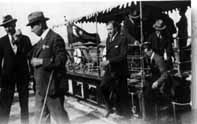
|
|
Sonraki
denemede, bizim 300 beygirlik Rayt J-69 motorlu Bellanca
kusursuz bir şekilde çalıştı. Uçuş esnasında sadece
bir kere tekledi. Newfoundlandin huzurlu kıyısından ayrılırken
hava iyice bozmaya başladı. Atlantik Okyanusu üzerinde
3.200 m yüksekliğe tırmanmak zorunda kaldığımız için aşağıdaki
mavi suları bile görmedik. Panodaki cihazlar düzensiz bir
biçimde hareket ediyorlardı. İlk birkaç saat yapay ufuk göstergesi
hiç çalışmadı. Bir keresinde ise, dolu yakıt bidonlarının
hareketi manyetik pusulayı allak bullak etti ve biz az kalsın
180 derecelik bir dönüş yapıp Newfoundlanda geri dönüyorduk.
Uyumak
neredeyse imkansızdı. Russell şekerleme yaparken kumanda
kolunun üstüne düştü ve ben yüksekliğimizi sabit
tutabilmek için çok uğraştım. Bir ara sanki saatler süren
bir uykuya daldım, fakat aslında bu yalnızca birkaç
dakikacık süren bir kestirmeydi. Russell, Vay, çok uzun
bir kestirme yaptın, biliyor musun? İnan çok iyi görünüyorsun!
diyerek uyandırdı beni. Bu aldatmacayı yuttum ve kendimi
gerçekten dinlenmiş hissettim.
Saatler
boyunca aynı yerde oturmaktan dolayı ağrıyan eklemlerimize
sürebileceğimiz tek şey diş macunuydu. Bu ilacın
bir işe yaradığı şüpheli görünse de, ovmanın kan dolaşımımıza
iyi geldiği kesindi.
29
gecesi korkulu rüyamız oldu. Dağların üstüne çöken
bulutlar yüzünden görüş mesafemiz neredeyse sıfırdı.
Bulutların üstüne çıkmak için 4.500 metreye yükselmemiz
gerekiyordu ve bu kanatlarda buzlanma yapabilirdi. En karanlık
saatleri Münih üzerinde defalarca tur atarak geçirdik.
Zirvelerin arasından, güneşin yüzünü göstermesiyle
korkumuz giderek kayboldu ve nihayet birbirimize bakıp gülüştük.
Şansımızın yaver gideceğini anlamıştık. Kanatlarımızın
altında Münih, Tuna nehri ve Balkan ülkeleri sırayla geçiyordu.
Nihayet, ufukta kadim kent İstanbulun minareleri göründü.
Nihai hedefimize ulaşmıştık. Fakat, indikten hemen sonra
sadece 20 dakikalık benzinimiz kaldığını farkettik.
Kader
ortağımız ihtiyar Cape Coddan aşağı indikten sonra
bizi ilk tebrik eden Amerikan Büyükelçisi Joseph Grew oldu.
Bay Grew ve kızı geceyi Yeşilköy Havaalanında geçirip
toplam 10 saat bizi beklemişler. Hatta az kalsın beklemekten
vazgeçip sefarethaneye döneceklermiş. Fakat inişi kaçırmanın
korkusuyla havaalanına geri dönmüşler. Grewin selamları
dostça ve içtendi ama sanki biraz da hüsran doluydu.
Galler ülkesine yaptığınız inişten dolayı üzgünüm
dedi. Fakat asıl durumu biz izah edince öğrendi. New
Yorkdaki kalkışımızdan 18 dakika sonra havalanan
Pangborn ve Herndon adlı tayyarecilerin seferi bizimki ile
karışmıştı. Dünya turuna çıkan bu tayyare yakıt almak
için Gallere iniş yapmıştı. Cape Codun kuyruk kısmında
bulunan barograf cihazı, 5011.8 mili 49 saat 8 dakikada uçtuğumuzu
gösteriyordu. Bunun anlamı, tek motorlu uçakla dünya
mesafe rekoru artık bize aitti. |
|
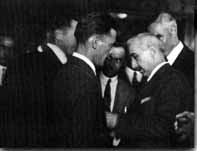
|
|
Türk
halkı bizi coşkulu karşıladı. Konakladığımız Pera
Palas Otelini saran kalabalık saatlerce oradan ayrılmadı.
Bense küvette uyuyakalmışım, boğulacağım diye sudan fırladım.
Uykumuzu yeterince aldıktan sonra oda servisini çağırdık.
Sigara ve içkiler dahil olmak üzere bir ziyafet çektik!
Fazla yemek ve uykusuzluktan üzerimize ağırlık çökmüş
olmalı ki, sigara izmaritlerden biri odadaki divanı yaktı!
10
gün boyunca akşam yemekleri, kabul törenleri, gece Boğazda
tekne turları sürüp gitti. Bir gün de Yalova Köşküne
Sakarya adlı tekne ile gidip Türkiye Cumhuriyeti
Cumhurbaşkanı Mustafa Kemal Atatürk ve Başbakanı İsmet
İnönünün
huzuruna çıktık. İkimize de Türkiyenin en büyük ödülü,
Şeref Madalyası ve birer tane Türk halısı takdim edildi.
Uzun
bir seferden sonra Cape Codun durumu, silindirleri yağlanmadığından
pek parlak değildi. Dönüş uçuşumuza hazırlanmak için
havaalanında saatler harcadık. Sonuçta New Yorka uçmak
yerine, Marsilyaya uçmaya karar verdik; orada da uçağımızı
demonte edip Excalibur adlı buharlı gemiye yükleyerek
evlerimize döndük. Amerikada bizi kahraman gibi karşıladılar.
Hem New Yorkda hem de Bostonda geçit törenleri yapıldı.
Cape Cod, Massachusettsdeki Hyannis dahil olmak üzere bir
sürü yerde söyleşiler ayarlandı, ziyafetler verildi.
Tarihi uçuşun birinci yıl dönümünü kutlamak amacıyla
Başkan Hoover bizi Beyaz Saraya davet edip
Distinguished Flying Cross madalyalarını takdim etti.
Kim
bu aşırı övgülerin uzun süre devam edeceğini bekler ki?
Yıllar geçtikçe randevu talepleri azaldı ve çevremizde şöhretli
günlerimizi hatırlayabilen eski ve yakın dostlar kaldı.
Yetenekli
ve hünerli tayyareci Russell Boardmanı 1933 yılında,
Bendix Hava Yarışlarında, kötü bir öne sahip Gee Bee
modeli uçağı kullanırken yitirdik. Dünya bir öncüyü
kaybetti. Bense hem en yakın dostumu hem de tanıdığım en
iyi insanı yitirdim.
Polandonun
öyküsü burada bitiyor. Belki bir-iki hususu da bizim
eklememiz gerekecek: 25 Temmuz 1981 tarihinde, bu rekor uçuşun
50. yılını şereflendirmek amacıyla Hyannis Belediye
Havaalanının adı, Boardman-Polando Havaalanı olarak değiştirildi.
John Polando, 13 Ağustos 1985 tarihinde Cape Cod
Hastanesinde, 83 yaşında vefat etti. |
|
|
|
Once
upon a time, in the days before jumbo jets, fly-by-wire
Global Positioning Satellite systems, in-flight movies, on
board duty-free shopping and the like, there was the amazing
flight of the Cape Cod. It was an historical occasion
that firmly connected the New Worlds most cosmopolitan
city, New York, to one of the worlds bravest, newest
countries, the Turkish Republic, a place where radical change
was the order of the day. It also proved to be the single
greatest event in Turkish-American relations to occur in the
20th century.
With
remarkable precision and steely courage, 33-year old Russell
Boardman, pilot and 29-year old John Polando, navigator, took
off from Brooklyns Floyd Bennett Field at 6:00 a.m. EST on
July 28, 1931 and steered their single-engine, high-wing
Bellauca eastward over an ocean and a continent to make a
three-point landing in the brave, new world of Turkey.
What
you are about to read is an article which was written 20 years
ago by John Polando. Due to the contract they made with the
New York Times back in 1931, Boardman and Polando were not
able to express freely to the Turkish press the entire story
as it truly happened. I obtained this article along with the
accompanying photographs from Johns lovely wife, Dorothy. I
only wish that both of them were with us today. I know they
would have been ecstatic to have seen it published in this
friendship and peace messages announcing web site.
Now
let me give the word to John Polando.
It
was in the early Twenties that Russell Boardman and I first
met and we were immediately attracted to each other. Our
vocations and avocations were identical. On the night of our
meeting, Russell was riding a motorcycle in a cycledrome at
Revere Beach and I was a fascinated spectator. Also, we had
both been bitten by the flying bug so we were spending much of
our time at airports, specifically East Boston (now Logan
International Airport). I got my license in December, 1927 and
he had earned his a short time before.
|
|
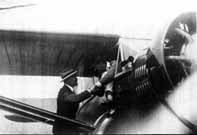
|
|
Flying
at that point was still in its infancy and records were
established one day and broken the next. Intrigued by this
phenomenon, Russell as early as 1930 began seriously
considering challenging the worlds longest distance record.
The current distance record had been established by Dieudonne
Coste and Maurice Bellonte in 1929 on a 4911 mile trip from
Paris to Manchuria. Russells destination must to be
accepted as a new record, exceed the then existing record by
62 miles. The distance factor ruled out Moscow or Rome.
Istanbul, Turkey was his final choice.
In
less time than it takes to tell it, the word got around that
Russell was contemplating such a trip. Scores of people begged
to be part of the adventure. Finally, Russell came to me and
said, John, how much do you weigh? One-twenty, I
replied. Okay, youll do. With that, the formalities
were completed and the planning began.
The
fuel capacity of the plane, as she was originally designed,
was insufficient for our needs, so Mr. Bellanca suggested that
we carry additional gas in five gallon cans. The main gas tank
was our seat. The auxiliary fuel was placed behind us within
easy reach for funneling into the main tank over our
shoulders. Disposing of the empty cans was a hazard and we
practiced for hours throwing empty cans over the outer harbor.
The can was held out the window. In spite of the careful
maneuvering, one can struck the stabilizer during the flight
when the handle broke off. The plane shook from the impact and
caused us some very anxious moments but no particular damage
resulted. |
|
Now,
pretty much in readiness, we had to await the weather reports.
Dr. Kimball was the meteorologist whose predictions were used
by practically every one of the pilots on the East Coast.
|

|
|
The
Cape Cod weighed 2,400 pounds empty, she grossed 7,460
pounds loaded for the flight with 720 gallons of fuel and 25
quarts of oil. Much must be said for the cooperation of the
telephone and electric companies who obligingly laid down the
poles on Flat bush Avenue that had proved to be a hazard on
low take-off at Floyd Bennett Field. In spite of this our
first attempt was aborted because we were so over grossed that
we were flying between the taller buildings of Brooklyn and we
were finally obliged to dump five hundred gallons of precious
fuel on that unlucky city before returning to Floyd Bennett.
The Bellanca, powered with a Wright J-69 300 horsepower
engine, performed perfectly. She sputtered just once on the
flight. The weather, after leaving the comforting coast of
Newfoundland, deteriorated considerably. We were forced to
climb to 12,000 feet over the Atlantic so we saw nothing of
the water in the passing. The instruments behaved erratically.
The artificial horizon failed to function within the first few
hours. Once the movement of the full fuel cans caused the
magnetic compass to fluctuate and we made a 1800 turn and
were, momentarily, headed back for Newfoundland.
Sleep
was virtually impossible. Russell drowsed briefly but in doing
so fell forward on the stick and it was almost impossible to
maintain altitude. I, too, dropped off for what seemed hours
but was in fact only a couple of minutes. Russell woke me with
a Hey you really had a long nap. You look great - really
terrific. The hoax worked like a charm. I really felt
rested and refreshed.
The
endless hours of sitting in one position is painful at best.
In our discomfort, we rubbed the only thing available on our
sore and aching joints toothpaste. It is doubtful if the
medication was helpful but the rubbing probably improved
the circulation.
The
night of the 29th was frightening. The clouds hung low over
the mountains, making the visibility practically zero. To rise
above the clouds meant ascending to 14,000 feet and we would
have picked up ice. The darkest hours were spent circling in a
valley near Munich. As the flow of the rising sun finally
fingered its way between the peaks and the fearful suspense
lessened, we grinned at each other. The odds were now more in
our favor. The city of Munich, the Danube, the Balkans slipped
slowly under our wings and, finally, the minarets of the
ancient city of Istanbul became visible on the horizon. We
were going to make our destination. We found we had only
twenty minutes of fuel left in our gas tanks when we landed. |
|

|
|
American
Ambassador Joseph Grew was the first to clasp our hands as we
climbed stiffly out of the fathful old Cape Cod. Mr.
Grew and his daughter had spent the night at the Yeşilköy
Airdrome, departed briefly, then had second thoughts and
returned for fear of missing our arrival. Grews greeting
was warm and cordial but tinged with disappointment. So
sorry you had to land in Wales, too bad. Mistakenly he
referred to American flyers Panghorn and Herndon, who were
making a routine fuel stop on their round-the-world flight.
The barograph in the tail section of the Cape Cod had
recorded 5011.8 miles in 49 hours and 8 minutes, which gave us
the worlds long distance record for a single-engine
aircraft.
The
welcome from the Turks was enthusiastic. Crowds stood for
hours around the Pera Palas Hotel where Russell and I were
attempting to unwind and rest in the bridal suite provided for
us. I fell asleep in the bathtub and came up sputtering. When
we finally awakened sufficiently to ask for food, we were
served a fabulous feast complete with drinks and cigarettes.
Too much food and too little real sleep made us both drowsy
and we set the sofa on fire with our smoking.
There
were banquets, receptions, moonlight boat rides on the
Bosphorus and trips to the summer palace of Mustafa Kemal Atatürk, President of Turkey. Each of us was presented with the
Turkish Medal of Honor Turkeys highest award by İsmet İnönü,
Prime Minister of Turkey, along with a beautiful Turkish rug.
The
Cape Cod was in sad shape after the long journey without
lubrication. We spent several hours at the airdrome readying
her for a return flight to Marseilles where she would be
crated and loaded aboard the steamship Excalibur for the trip
back home. |
|
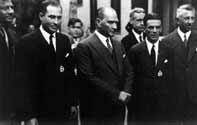
|
|
The
return to the United States was a heros welcome with a
ticker tape parade in New York and another in Boston. There
were speaking engagements and banquets, including one in
Hyannis on Cape Cod. Then we were notified that President
Hoover would present us the Distinguished Flying Cross on the
White House lawn.
One
does not, cannot, expect such adulation to last and it
dwindled to infrequent speaking engagements and mostly old,
close friends who remember our days of glory.
In
1933, Russell Boardman, a skillful and talented pilot, was
killed in the infamous Gee Bee racer. The world lost a pioneer
and I lost my closest friend and possibly the finest man I
have ever known.
Polando's
story finished here. May be I may put some additional
informations. On July 25th, 1981, the name of Hyannis
Municipal Airport was changed to Boardman-Polando Field
in honor of the distance record the two pioneers set 50 years
before. On August 13th, 1985, John Polando passed away at Cape
Cod Hospital, Massachusetts. He was 83 years old. |
|
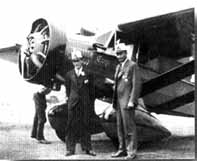
|
|